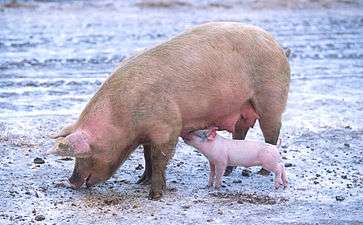Gammon (meat)
.jpg)
Gammon is the hind leg of pork after it has been cured by dry-salting or brining.[1] It may or may not be smoked. Like bacon, it needs to be cooked before it can be eaten.[2] It may be sold on-the-bone or without bone, or as steaks or slices. It differs from ham in that ham is cured after being cut from the carcass and the curing process for ham may be different.[3]
Gammon hock (or knuckle) is the foot end of the joint, and contains more connective tissue and sinew.[4]
Joints of cooked gammon are often served at Christmas, or on Boxing Day.
The words gammon, ham and bacon are sometimes used interchangeably. Particularly in the US, "fresh ham" may refer to raw, uncured hind leg of pork.[5]
Glazed gammon, or glazed ham in the US, is coated with a flavoured or spiced sugar solution before cooking. This caramelizes during cooking and also gives a distinctive appearance. This may be enhanced by scoring the skin in a diamond pattern beforehand, or by sticking the joint with cloves.[6]
The word "gammon" is related to the French word jambon, meaning "ham", which in turn is derived from Late Latin gamba, meaning "leg".[7].
See also
References
- ↑ "Gammon recipes - BBC Food". www.bbc.co.uk.
- ↑ W K H Bode; M J Leto. The Larder Chef. Routledge; 25 June 2012. ISBN 978-1-136-35712-1. p. 178–.
- ↑ Charles Gordon Sinclair. International Dictionary of Food and Cooking. Taylor & Francis; January 1998. ISBN 978-1-57958-057-5. p. 252–.
- ↑ GOOD HOUSEKEEPING. Gh Food Encyclopedia. Anova Books; 2009. ISBN 978-1-84340-503-0. p. 185–.
- ↑ Ham and Food Safety, USDA, retrieved 2013-12-28
- ↑ "10 Ridiculously Easy Ham Glaze Recipes". Betty Crocker.
- ↑ "gammon - Origin and meaning of gammon by Online Etymology Dictionary". www.etymonline.com.


